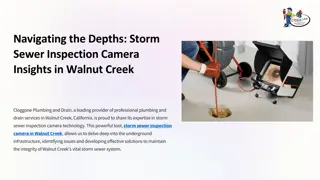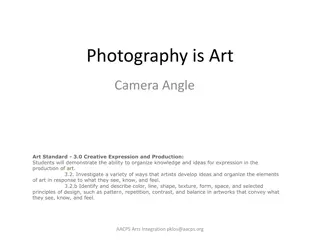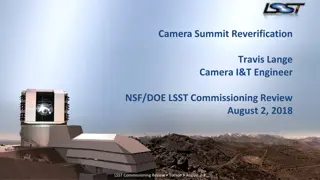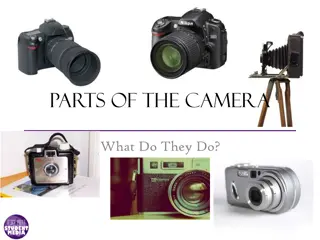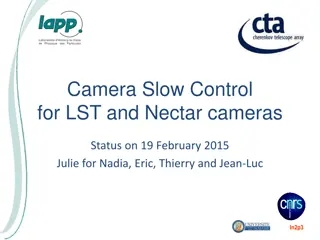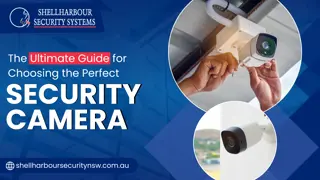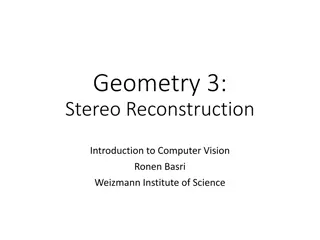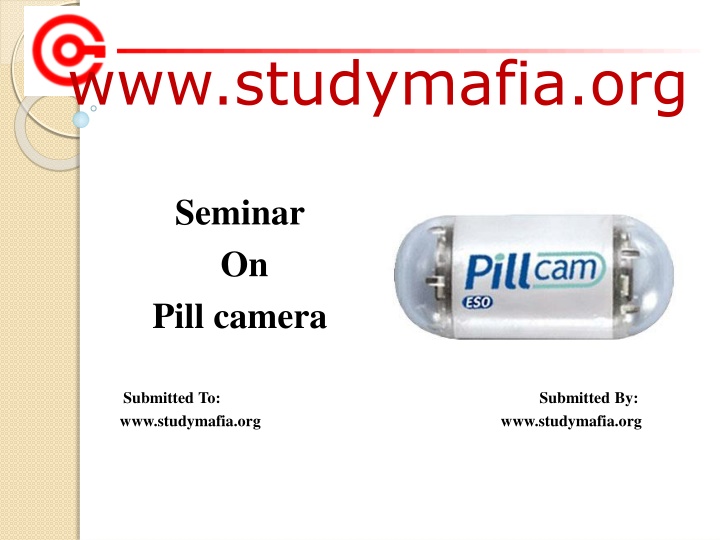
Innovative Capsule Camera Technology for Non-Invasive Diagnosis
Explore the revolutionary capsule camera technology that enables non-invasive diagnostic imaging inside the body. This advanced device, resembling a small pill, captures high-quality images as it travels through the digestive system, aiding in accurate medical diagnoses without the need for invasive procedures. Discover the components, functioning, benefits, and drawbacks of capsule cameras for efficient healthcare applications.
Download Presentation

Please find below an Image/Link to download the presentation.
The content on the website is provided AS IS for your information and personal use only. It may not be sold, licensed, or shared on other websites without obtaining consent from the author. If you encounter any issues during the download, it is possible that the publisher has removed the file from their server.
You are allowed to download the files provided on this website for personal or commercial use, subject to the condition that they are used lawfully. All files are the property of their respective owners.
The content on the website is provided AS IS for your information and personal use only. It may not be sold, licensed, or shared on other websites without obtaining consent from the author.
E N D
Presentation Transcript
www.studymafia.org Seminar On Pill camera Submitted To: www.studymafia.org www.studymafia.org Submitted By:
CONTENTS Introduction to Capsule Camera Conventional Method Description Components of Capsule Camera Inside a Capsule Capsule Camera Endoscope Procedure Uses Advantages Drawbacks & Overcomes Conclusion
Introduction to Capsule Camera .Imagine a vitamin pill-sized camera that could travel through your body taking pictures, helping diagnose a problem which doctor previously would have found only through surgery. .
Conventional Method Endoscopic examination is replaced by PILL CAMERA.
Description The device, called the given Diagnostic Imaging System, comes in capsule form and contains a camera, lights, transmitter and batteries. The latest pill camera is sized at 26*11 mm and is capable of transmitting 50,000 color images during its traversal through the digestive system of patient.
Components Of Capsule camera LIGHTING DEVICE CMOS LENS IMAGE SENSOR TRANSMITTING ELECTRODE
Inside a Capsule Camera OPTICAL DOME ANTENNA 5 7 LENSHOLDER ASIC TRANSMITTER LENS BATTERY ILLUMINATING LED S CMOS IMAGE SENSOR
1.Optical Dome This shape results in easy orientation of the capsule axis along the central axis of small intestine and so helps propel the capsule forward easily. The Optical Dome contains the Light Receiving Window . 2.Lens Holder The Lens Holder is that part of the capsule which accommodates the lens. The lens is tightly fixed to the holder so that it doesn t get dislocated anytime.
3.Lens The Lens is an integral component of the capsule. It is arranged behind the Light Receiving Window. 4.Illuminating LED s Around the Lens & CMOS Image Sensor, four LED s (Light Emitting Diodes) are present. These plural lighting devices are arranged in donut shape.
5.CMOS Image Sensor CMOS (Complementary Metal Oxide Semiconductor) Image Sensor is the most important part of the capsule. It is highly sensitive and produces very high quality images. It has 140 field of view and can detect objects as small as possible. 6.Battery Battery used in the capsule is button shaped and are two in number as shown. The batteries are arranged together just behind the CMOS Image Sensor. Silver Oxide primary batteries are used (Zinc/Alkaline Electrolyte/Silver Oxide). Such a battery has a even discharge voltage, disposable and doesn t cause harm to the body.
7.ASIC Transmitter The ASIC (Application Specific Integrated Circuit) Transmitter is arranged behind the Batteries as shown. Two Transmitting Electrodes are connected to the outlines of the ASIC Transmitter. These electrodes are electrically isolated from each other. 8.Antennae As shown, the Antennae is arranged at the end of the capsule. It is enclosed in a dome shaped chamber.
Endoscopy Procedure Capsule is swallowed by the patient like a conventional pill. It takes images as it is propelled forward by peristalsis. A wireless recorder, worn on a belt, receives the images transmitted by the pill. A computer workstation processes the data and produces a continuous still images.
Movement Of Capsule Through The Digestive System COMPUTER DATA RECORDER Data Acquisition & Storage Of Data On Computer Produces two images per second, approximately 2,600 high quality images.
Images obtained by capsule camera
USES Crohn's Disease. Malabsorption Disorders. Tumors of the small intestine & Vascular Disorders. Ulcerative Colitis Medication Related To Small Bowel Injury.
Advantages Painless, no side affects or complications. Miniature size, so can move easily through the digestive system. Accurate, precise and effective. Images taken are of very high quality which are sent almost instantaneously to the data recorder for storage. Made of bio-compatible material, doesn t cause any harm to the body.
Drawbacks & Overcomes . 1.Patients with gastrointestinal structures or narrowing are not good candidates for this procedure due to the risk of obstruction. The first drawback is overcome using another product manufactured with the help of nanotechnology which is the rice- grain sized motor. 2. The Pill will get stucked if there is a partial obstruction in the small intestine. 3. Impossible to control Camera behavior. These two drawbacks can be overcome using a bi-directional telemetry Camera.
Conclusion The Given Endoscopy capsule is a pioneering concept for Medical Technology of the 21st century. The endoscopy system is the first of its kind to be able to provide non-invasive imaging of the entire small intestine. It has revolutionized the field of diagnostic imaging to a great extent and has proved to be of great help to physicians all over the world.
Reference www.google.com www.wikipedia.com www.studymafia.org




